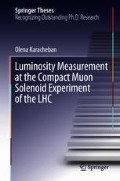Abstract
The era of colliders in particle physics started in the 1960-ties and has developed from MeV to TeV energies. It increased our knowledge and understanding of physics laws in the subnuclear domain at distance scales of about \(10^{-18}\) m. There are two families of colliders: linear colliders, where particles are accelerated in opposite directions and brought to collision at one interaction point, and circular colliders, where two particle beams are accelerated in opposite directions in a ring-shaped accelerator, stored and collided in particular “interaction points”. The interaction point is surrounded by dedicated particle detectors comprised of several subdetectors using a range of technologies. The information recorded from all subdetectors is used for the measurement of energies and momenta of almost all particles created in a collision.
Access this chapter
Tax calculation will be finalised at checkout
Purchases are for personal use only
References
J. Bennett et al. Design concept for a \(100\,GeV~e^{+}e^{-}\) storage ring (LEP), CERN 77-14 (1977)
H. Schopper, LEP-The Lord of the Collider Rings at CERN 1980-2000, Springer 2009, IBN 9788-3-540-89300-4
LEP Working groups, Large Electron-Positron Collider experiments, LEP, CERN-LEPC-97-11 (1996–2000)
The European Organization for Nuclear Research, https://home.cern/
G. Wolf, HERA: Physics, Machine and Experiments. Springer, Boston, MA (1987) https://doi.org/10.1007/978-1-4684-5401-7_6
G.A. Voss, B.H. Wiik, The electron-proton collider HERA. Annu. Rev. Nucl. Part. Sci. 44, 413–52 (1994)
DESY home page http://www.desy.de/about_desy/desy/index_eng.html
R.S. Moore, Tevatron collider status and prospects. in Proceedings of the DPF-2009 Conference, Detroit, MI, (2009)
Fermilab home page, http://www.fnal.gov/pub/about/index.html
S.L. Glashow, Partial-symmetries of weak interactions. Nucl. Phys. 22, 579–588 (1961)
A. Salam, Elementary Particle Theory, ed. Svartholm, N., Almquist and Wiksell, Stockholm, 367 (1968)
S. Weinberg, A model of leptons. Phys. Rev. Lett. 19, 1264 (1967)
G. Arnison et al., Experimental observation of lepton pairs of invariant mass aroud 95 GeV/c\(^2\) at the CERN SPS collider. Phys. Lett. B 125(5), 398–410 (1983)
G. Arnison et al., Experimental observation of isolated large transverse energy electrons with assiciated missing energy at \(\sqrt{s}=540 GeV\). Phys. Lett. B 122(1), 103–116 (1983)
P. Bagnaia et al., Evidence for \(Z~\rightarrow ~e^+e^-\)at the CERN anti-pp collider. Phys. Lett. B 129(5), 130–140 (1983)
P. Bagnaia et al., Observation of single isolated electrons of high transverse momentum in events with missing transverse energy at the CERN anti-pp collider. Phys. Lett. B 122(5–6), 476–485 (1983)
The ALEPH, DELPHI, L3, OPAL, SLD Collaborations, the LEP Electroweak Working Group, the SLD Electroweak and Heavy Flavour Groups, Precision electroweak measurements on the Z resonance. Phys. Rept. 427, 257–454 (2006)
David J. Gross and Frank Wilczek, Ultraviolet behavior of non-abelian gauge theories, Phys. Rev. Lett. 30, 1343 Published 25 June 1973
H. David Politzer, Reliable perturbative results for strong interactions. Phys. Rev. Lett. 30, 1346 Published 25 June 1973
M. Peskin, D. Schroeder, An Introduction To Quantum Field Theory, Perseus Books Publishing (1995)
D0 Collaboration, Search for high mass top quark production in \(p\bar{p}\) Collisions at\(\sqrt{s} = 1.8 TeV\). Phys. Rev. Lett. 74(13), 2422–2426 (1995)
C.D.F. Collaboration, Observation of top quark production in \(p\bar{p}\) Collisions with the collider detector at fermilab. Phys. Rev. Lett. 74(14), 2626–2631 (1995)
D0 Collaboration, Design Report: The D0 Experiment at the Fermilab Antiproton—Proton Collider, FERMILAB-DESIGN-1984-02, Experiment: FNAL-E-0740 (1984)
CDF Collaboration, The CDF-II detector: Technical design report, FERMILAB-DESIGN-1996-01, FERMILAB-PUB-96-390-E, Experiment: FNAL-E-0741 (1996)
L. Evans, P. Bryant (eds.), LHC Machine (2008) JINST 3S08001
ATLAS Collaboration, Atlas detector and physics performance: Technical Design Report, Volume 1, CERN-LHCC-99-14, ATLAS-TDR-14
ATLAS Collaboration, Atlas detector and physics performance: Technical Design Report, Volume 2, CERN-LHCC-99-15, ATLAS-TDR-15
CMS Collaboration, CMS physics TDR (PTDR1), Detector Performance and Software, CERN-LHCC-2006-001
CMS Collaboration, The CMS experiment at LHC, JINST 3 (2008), https://doi.org/10.1088/1748-0221/3/08/S08004
ALICE Collaboration, Technical Proposal for A Large Ion Collider Experiment at the CERN LHC, CERN/LHCC/95-71 (1995)
LHCb Collaboration, LHCb: Technical Proposal, CERN-LHCC-98-004 (1998)
The ATLAS Collaboration, Observation of a new particle in the search for the Standard Model Higgs boson with the ATLAS detector at the LHC. Phys. Lett. B 716, 1 (2012). https://doi.org/10.1016/j.physletb.2012.08.020. arXiv:1207.7214
The CMS Collaboration, Observation of a new boson at a mass of 125 GeV with the CMS experiment at the LHC. Phys. Lett. B 716, 30 (2012). https://doi.org/10.1016/j.physletb.2012.08.021. arXiv:1207.7235
H.J. Bhabha, The scattering of positrons by electrons with exchange on diracś theory of the positron. Proc. Roy. Soc. A154, 195 (1936)
S. van der Meer, Calibration of the Effective Beam Height in the ISR, CERN-ISR-PO-68-31 (1968)
CMS Collaboration, CMS Luminosity Based on Pixel Cluster Counting—Summer 2012 Update, CMS Physics Analysis Summary LUM-12-001 (2012)
CMS Collaboration, CMS Luminosity Measurement for the 2017 Data Taking Period, CMS Physics Analysis Summary LUM-17-004 (2017)
Author information
Authors and Affiliations
Corresponding author
Rights and permissions
Copyright information
© 2018 Springer International Publishing AG, part of Springer Nature
About this chapter
Cite this chapter
Karacheban, O. (2018). Thesis Introduction. In: Luminosity Measurement at the Compact Muon Solenoid Experiment of the LHC . Springer Theses. Springer, Cham. https://doi.org/10.1007/978-3-319-93139-5_1
Download citation
DOI: https://doi.org/10.1007/978-3-319-93139-5_1
Published:
Publisher Name: Springer, Cham
Print ISBN: 978-3-319-93138-8
Online ISBN: 978-3-319-93139-5
eBook Packages: Physics and AstronomyPhysics and Astronomy (R0)

